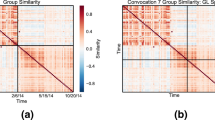Abstract
The widespread availability of Customer Relationship Management applications in modern organizations, allows companies to collect and store vast amounts of high-detailed customer-related data. Making sense of these data using appropriate methods can yield insights into customers’ behaviour and preferences. The extracted knowledge can then be explored for marketing purposes. Social Network Analysis techniques can play a key role in business analytics. By modelling the implicit relationships among customers as a social network, it is possible to understand how patterns in these relationships translate into competitive advantages for the company. Additionally, the incorporation of the temporal dimension in such analysis can help detect market trends and changes in customers’ preferences. In this paper, we introduce a methodology to examine the dynamics of customer communities, which relies on two different time window models: a landmark and a sliding window. Landmark windows keep all the historical data and treat all nodes and links equally, even if they only appear at the early stages of the network life. Such approach is appropriate for the long-term analysis of networks, but may fail to provide a realistic picture of the current evolution. On the other hand, sliding windows focus on the most recent past thus allowing to capture current events. The application of the proposed methodology on a real-world customer network suggests that both window models provide complementary information. Nevertheless, the sliding window model is able to capture better the recent changes of the network.











Similar content being viewed by others
Notes
A video version of this figure is available online at http://www.youtube.com/watch?v=eEQpjspkj_8 (landmark window) and http://www.youtube.com/watch?v=X4_jI8Q4cWQ (sliding window).
A video version of this figure is available online at http://www.youtube.com/watch?v=SyR5jmU6OUk.
References
Asur S, Parthasarathy S, Ucar D (2009) An event-based framework for characterizing the evolutionary behavior of interaction graphs. ACM Trans Knowl Discov Data 3(4):16:1–16:36
Bastian M, Heymann S, Jacomy M (2009) Gephi: an open source software for exploring and manipulating networks. In: Third International conference on weblogs and social media. http://www.aaai.org/ocs/index.php/ICWSM/09/paper/view/154
Berger-Wolf T, Tantipathananandh C, Kempe D (2010) Dynamic community identification. Springer, New York, pp 307–336
Blondel V, Guillaume JL, Lambiotte R, Lefebvre E (2008) Fast unfolding of communities in large networks. J Stat Mech Theory Exp 2008(10):P10008
Bródka P, Saganowski S, Kazienko P (2013) Ged: the method for group evolution discovery in social networks. Soc Netw Anal Min 3(1):1–14
Brin S, Page L (1998) The anatomy of a large-scale hypertextual web search engine. Comput Netw ISDN Syst 30(1–7):107–117
Danon L, Diaz-Guilera A, Duch J, Arenas A (2005) Comparing community structure identification. J Stat Mech Theory Exp 2005(09):P09008
Datar M, Gionis A, Indyk P, Motwani R (2002) Maintaining stream statistics over sliding windows. SIAM J Comput 31(6):1794–1813
Falkowski T, Bartelheimer J, Spiliopoulou M (2006) Mining and visualizing the evolution of subgroups in social networks. In: Proceedings of the 2006 IEEE/WIC/ACM international conference on web intelligence, WI ’06. IEEE Computer Society, Washington, pp 52–58
Fortunato S (2010) Community detection in graphs. Phys Rep 486(3–5):75–174
Gehrke J, Korn F, Srivastava D (2001) On computing correlated aggregates over continual data streams. ACM SIGMOD Rec 30(2):13–24
Greene D, Doyle D, Cunningham P (2010) Tracking the evolution of communities in dynamic social networks. In: Proceedings of the 2010 international conference on advances in social networks analysis and mining, ASONAM’2010. IEEE Computer Society, pp 176–183
Kawadia V, Sreenivasan S (2012) Online detection of temporal communities in evolving networks by estrangement confinement. ArXiv e-prints 1203.5126
Lin YR, Chi Y, Zhu S, Sundaram H, Tseng BL (2009) Analyzing communities and their evolutions in dynamic social networks. ACM Trans Knowl Discov Data 3:8:1–8:31
Newman MEJ (2003) The structure and function of complex networks. SIAM Rev 45(23):167–228
Newman MEJ, Girvan M (2004) Finding and evaluating community structure in networks. Phys Rev E 69(2):026113
Oliveira M, Gama J (2012) A framework to monitor clusters’ evolution applied to economy and finance problems. Intell Data Anal 16:93–111
Palla G, Barabasi AL, Vicsek T (2007) Quantifying social group evolution. Nature 446:664–667
Raghavan UN, Albert R, Kumara S (2007) Near linear time algorithm to detect community structures in large-scale networks. Phys Rev E 76(036):106
Saganowski S, Bródka P, Kazienko P (2012) Influence of the dynamic social network timeframe type and size on the group evolution discovery. In: IEEE/ACM international conference on advances in social networks analysis and mining. IEEE Computer Society, Washington, pp 678–682
Spiliopoulou M, Ntoutsi I, Theodoridis Y, Schult R (2006) Monic: modeling and monitoring cluster transitions. In: Proceedings of the 12th ACM SIGKDD international conference on knowledge discovery and data mining, KDD ’06. ACM, New York, pp 706–711
Takaffoli M, Sangi F, Fagnan J, Zaiane OR (2011) Community evolution mining in dynamic social networks. Proc Soc Behav Sci 22:49–58
Wasserman S, Faust K (1994) Social network analysis: methods and applications. Cambridge University Press, Cambridge
Acknowledgments
The authors acknowledge the support of the European Commission through the project MAESTRA (Grant Number ICT-750 2013-612944) and projects “NORTE-07-0124-FEDER-000056/59”, financed by the North Portugal Regional Operational Programme (ON.2—O Novo Norte), under the National Strategic Reference Framework (NSRF), through the Development Fund (ERDF), and by national funds, through the Portuguese funding agency, Fundação para a Ciência e a Tecnologia (FCT). Márcia Oliveira was also funded by FCT, under the PhD grant SFRH/BD/81339/2011. We also thank the anonymous reviewers for their valuable comments and suggestions on earlier versions of this manuscript. A special thanks to Rui Sarmento for helping us run the GED method script in Microsoft SQL Server Express 2012.
Author information
Authors and Affiliations
Corresponding author
Rights and permissions
About this article
Cite this article
Oliveira, M., Guerreiro, A. & Gama, J. Dynamic communities in evolving customer networks: an analysis using landmark and sliding windows. Soc. Netw. Anal. Min. 4, 208 (2014). https://doi.org/10.1007/s13278-014-0208-2
Received:
Revised:
Accepted:
Published:
DOI: https://doi.org/10.1007/s13278-014-0208-2




